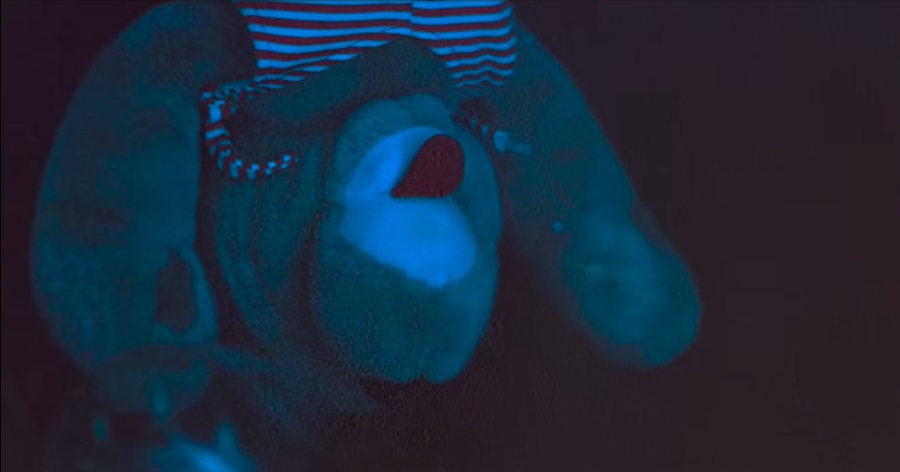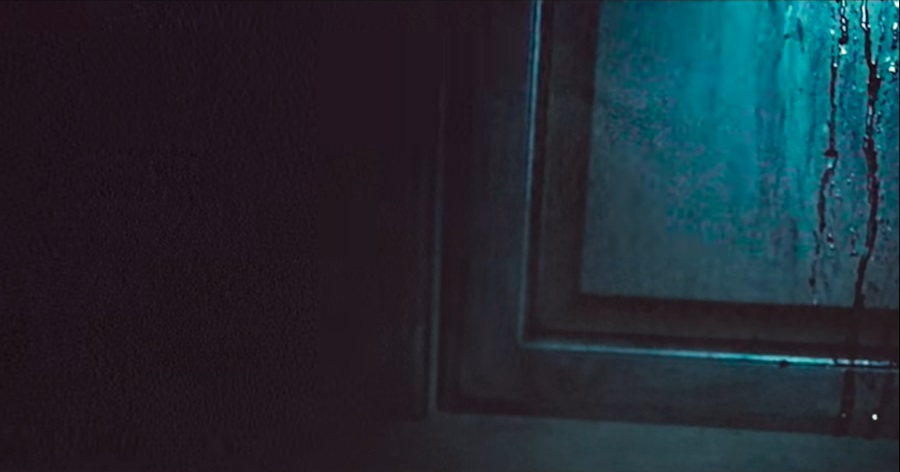• Skinamarink is a 2022 experimental horror film directed by Kyle Edward Ball that delves into the eerie and unsettling world of childhood fears.
• The film centres on two young siblings, Kevin (Lucas Paul) and Kaylee (Dali Rose Tetreault), who awaken one night to find their father (Ross Paul) missing and their home slowly transforming into a surreal and terrifying space.
• As they navigate through the increasingly strange and disorienting environment, they encounter disturbing phenomena such as disappearing doors and windows, haunting voices, and mysterious entities that seem to have taken over their home.
• The movie is a deeply atmospheric exploration of fear, disorientation, and the terror of being trapped in an inescapable nightmare.
A Haunting Atmosphere and Disorienting Visuals
Skinamarink thrives on creating a sense of dread and discomfort through its atmospheric storytelling and disorienting visuals. The film employs a grainy, lo-fi aesthetic, with long, lingering shots of the dark, empty house that heighten the feeling of unease. The lack of a clear narrative, combined with unsettling sounds and visuals, makes the house itself feel like a malevolent entity. The result is a film that is less about traditional scares and more about evoking a deep, primal fear of the unknown.
Childhood Symbols Turned Terrifying: Cartoons, Toys, and the Fisher-Price Chatter Telephone
One of the film's most unsettling aspects is its use of familiar childhood symbols—cartoons, toys, and the Fisher-Price Chatter Telephone—to evoke terror. These once comforting objects are distorted into sources of dread, emphasizing the theme of childhood fears being magnified in the dark.

• Cartoons and Toys: Throughout the film, Kevin and Kaylee are surrounded by the comforting presence of toys and old cartoons playing on TV. However, in the context of their terrifying situation, these elements take on a menacing tone. The juxtaposition of innocent childhood entertainment with the nightmarish events unfolding around the siblings deepens the sense of unease.
• Fisher-Price Chatter Telephone: The Fisher-Price Chatter Telephone, a staple of many childhoods, becomes one of the film's biggest scares. This toy, with its smiling face and friendly design, suddenly feels ominous as it takes on a life of its own in the dark, echoing the film's theme of familiar objects becoming terrifying when viewed through the lens of fear.
The Parents and the Entity's Manipulation
In Skinamarink, the parents of Kevin and Kaylee are central to the film's unsettling atmosphere, though their presence is more haunting than comforting. The father (Ross Paul) is conspicuously absent for most of the film, leaving the children to navigate the horrors of their home alone. The mother, while not physically present, is used by the malevolent entity to manipulate and terrorize the children.
In one particularly chilling scene, the entity deceives Kevin into believing that his mother is sitting beside him on the bed. This eerie illusion exacerbates Kevin's confusion and fear, as he is left unsure of what is real and what is a cruel trick. The entity's manipulation deepens the children’s isolation, turning their home into a nightmarish maze of deceit and terror. By distorting the comforting presence of their mother, the film taps into the primal fear of abandonment and betrayal by those who are meant to protect them.
The Number 572, Upside-Down House, and Blood Stains: Symbols of a Fractured Reality

Several cryptic elements in the film have sparked intense discussion and interpretation among viewers:
• The Number 572: Toward the end of the film, the number "572" appears on the screen, leading to various interpretations. One prominent theory suggests that Kevin has been in a coma for 572 days following a head injury. According to this interpretation, the events of the film represent Kevin’s subconscious mind as it struggles to make sense of his condition.
• The Upside-Down House: At one point in the film, the house is shown upside-down, further emphasizing the disorienting and nightmarish quality of the story. This visual could symbolize an inversion of reality, where the familiar becomes strange and threatening. It may also represent a world turned upside down, where normal rules no longer apply, amplifying the sense of helplessness and terror experienced by the characters.

• Blood Stains: The appearance of blood stains, particularly in connection with Kevin’s injury, supports the theory that the entire film takes place within his mind. These stains could symbolize the trauma he has suffered, both physically and psychologically, and the inescapable nature of his situation.
The Entity’s Cruelty: Kaylee’s Disfigurement and Kevin’s Tragic Obedience
As the film progresses, the entity’s malevolent influence becomes increasingly personal and terrifying. One of the most harrowing moments occurs when the entity gruesomely removes Kaylee’s eyes and mouth, rendering her helpless and silent. This act strips Kaylee of her ability to see and speak, symbolizing a complete loss of agency and turning her into a mere vessel for the entity’s cruelty.
Kevin also falls victim to the entity's sinister control. In a particularly disturbing scene, Kevin is coerced into stabbing himself in the eye under the entity's command. This horrifying act of self-mutilation underscores the entity's psychological grip on Kevin, pushing him to harm himself in a desperate attempt to appease the unseen force. Following this, Kevin calls 911 as instructed by the entity, further demonstrating his helplessness and the terrifying control the entity exerts over him.
Understanding the Ending of Skinamarink
The ending of Skinamarink is as ambiguous and unsettling as the rest of the film. Kevin, the young boy, seems to be caught in an endless nightmare, unable to escape the horrors within his home. The film concludes with a shadowy figure whispering to Kevin, asking him to sleep, followed by prolonged darkness, leaving the audience in a state of unease.
This ending suggests that Kevin is trapped in an eternal loop of fear and disorientation, possibly due to his coma. This interpretation aligns with the theory that the film represents his subconscious mind grappling with his trauma. The lack of resolution reinforces the film's exploration of childhood fears and the feeling of being lost in a world that no longer makes sense.
Why the Ending Turned Out This Way?
The film's conclusion is deliberately left open to interpretation, reflecting the experimental nature of Skinamarink. Director Kyle Edward Ball crafted the movie to evoke a visceral, emotional response rather than provide a clear narrative. The ambiguous ending plays into the film's themes of fear, isolation, and the unknown. By leaving questions unanswered, the film ensures that its horror lingers with the audience long after the credits roll.
Theories and Interpretations
Fans of the film have proposed various theories to explain the ending and the film's cryptic elements:
1. Coma Theory: As mentioned earlier, the theory that Kevin is in a coma and the events of the film are his mind's attempt to cope with his injury is one of the most popular explanations. The number 572 and the recurring motifs of blood and darkness support this interpretation.
2. Childhood Fear Manifestation: Another theory suggests that the film is a representation of Kevin's deepest childhood fears, brought to life in the most terrifying way possible. The house, once a place of safety, becomes a prison, reflecting how children's imaginations can turn the familiar into the frightening.
3. Purgatory or Limbo: Some viewers interpret the film as depicting a form of purgatory or limbo, where Kevin is stuck between life and death, unable to move on. The endless loop of fear and the lack of escape reinforce this idea.
Conclusion: A Haunting Exploration of Fear
Skinamarink is a unique and unsettling horror film that leaves much to the viewer's interpretation. Its ending, like the rest of the film, is enigmatic and disturbing, forcing audiences to grapple with the unresolved terror it presents. Whether viewed as a depiction of a child's nightmare, a psychological exploration of trauma or a journey through purgatory, Skinamarink remains a deeply haunting experience that stays with you long after the lights go out.






